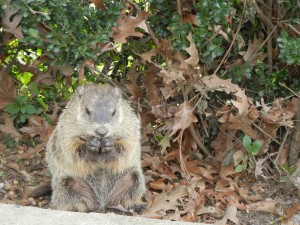WASHINGTON — Marine Corps Base Quantico, Va., has a “Caddyshack” problem, with groundhogs tearing up the golf course much as the gopher did in the cult comedy film.
The rodents run wild on the base and it is getting worse on the Medal of Honor Golf Course, said John Noblin, maintenance supervisor there for 10 years.
LITTLE KNOWN GROUNDHOG FACTS
+Groundhogs, also known as woodchucks in different parts of the state, can grow to be 20 to 27 inches.
+Although they’re in the squirrel family, groundhogs are distinct. The animals have a small head and short legs, and gray-brown fur. Their feet have a darker fur.
+A groundhog eats about 1.5 pounds of food a day and may eat more than a third of its weight in a single day.
+Farmers often complain about burrows because larger holes can cause a tractor tire to run into one, and it can occasionally cause damage to equipment.
+Even rarer, the burrows can injure large animals like cows and horses if they get stuck in a hole.
+Most groundhogs will live between 4 and 5 years, and when they wake up in early winter, they’ll mate and give birth by April. They don’t have a large litter their second year, but by the third year they’ll have a litter of 4 or 5 young groundhogs.
— From interviews with Virginia Department of Game and Inland Fisheries employees.
“The problem we have is they destroy ground around some of the tee-boxes,” he said, and the flowers have been replaced with oriental grass because the critters eat as many buds as possible. They’ve even chewed through the irrigation lines on the golf course.
However, unlike Carl Spackler, the “Caddyshack” greenskeeper played by Bill Murray, Quantico golf course workers can’t resort to plastic explosives to get rid of the groundhogs. Noblin said his team could spend every day trying to fill holes, but it wouldn’t be worth their effort.
“We could go out and replace it today, and come back tomorrow and there would be another hole,” he said.
For the rest of the base, groundhogs are just an annoyance residents learn to live with.
Tim Stamps, head of Quantico’s fish, wildlife and agronomy section, said most of the groundhogs are on the main side of the base, east of Interstate 95 near housing and open grass. The western section, he said, is more forested and less desirable a habitat for the animal.
The base groundhog population is stable, and any effort to eradicate them would only bring temporary results as they likely would be quickly replaced by others, said Stamps, who has worked at Quantico for 30 years.
For hunters off base, the critters are fair game.
Classified as a “nuisance” animal, they can be hunted year-round, said Marc Puckett, a wildlife biologist for the Virginia Department of Game and Inland Fisheries.
At Quantico, hunting is not allowed on the eastern side of the base, Stamps said. So, game officials occasionally will trap groundhogs that pop up near someone’s home and move them to the forested western side, where there are hunting grounds.
But those hunting grounds are far from where groundhogs like to burrow, so it’s not common for a hunter to shoot one on base, he said.
Most groundhogs in Virginia weigh between eight and 10 pounds, Puckett said, but they can grow to be 15 pounds. Their tunnels can get up to 5 feet deep and 14 to 30 feet long, and groundhogs will set up different dens for summer and winter.
Stamps said having a garden at Quantico is too difficult because of the animals.
“I’m sure residents would love to have a garden, but the animals — particularly the deer — would make that impossible,” Stamps said.
“Groundhogs would try to have their share.”
After eating as much as they can in the summer, groundhogs will hibernate from November to February.
Puckett said that as soon as a couple of heavy frosts hit an area, groundhogs head into hibernation.
Similarly, groundhogs may emerge in the first warm days in January or February.
But as Punxsutawney Phil can attest, just because a groundhog wakes up in time for Groundhog Day on Feb. 2, doesn’t mean it will stay above ground. If it’s cold, it’ll wait for warmer weather.
While humans aren’t likely to have direct contact with groundhogs because the animal is so shy, groundhogs don’t carry many diseases and are no real threat to humans or pets, Puckett said.
But they are not always where you might expect them to be.
“They’re good climbers and it’s not uncommon to see them in a tree from time to time,” he said, “and they’re good swimmers.”

